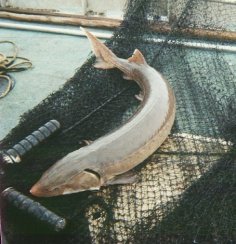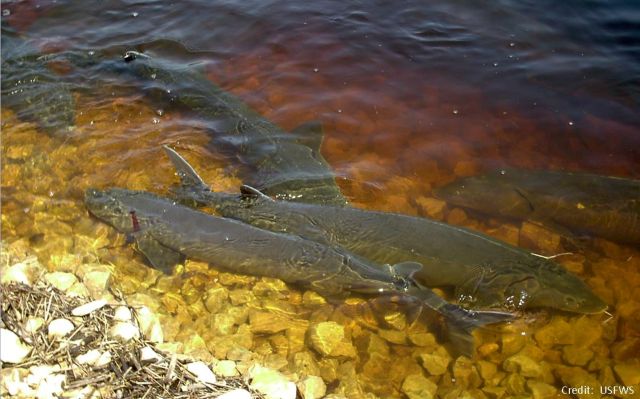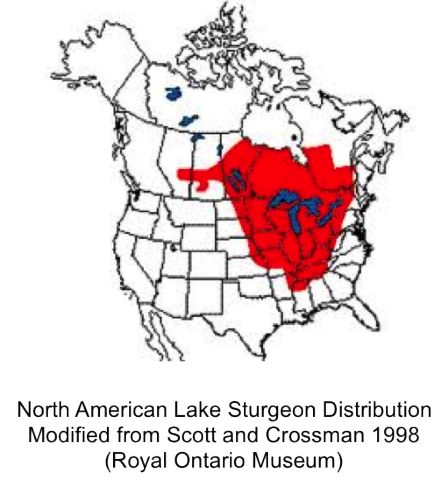 |
Canku Ota
|
 |
|
(Many Paths)
|
||
|
An Online Newsletter
Celebrating Native America
|
||
|
September 2015 - Volume
13 Number 9
|
||
|
|
||
|
Lake Sturgeon
(Acipenser fulvescens) |
||
|
by U.S. Fish and Wilddlife
Service
|
||
Lake Sturgeon Biology Lake sturgeon are the only sturgeon species endemic to the Great Lakes basin and are the largest freshwater fish indigenous to that system. Lake sturgeon can be considered a nearshore, warmwater species with water temperature and depth preferences of low 50s to mid-60oF and 15-30 feet, respectively. Lake sturgeon are benthivores, feeding on small invertebrates such as insect larvae, crayfish, snails, clams, and leeches.
As a consequence of interrupted spawning cycles, only 10-20% of adult lake sturgeon within a population are sexually active and spawn during a given season. Little is known about seasonal movements of lake sturgeon. Some adult lake sturgeon have been found to remain in a small territory during the summer months. While others have been observed long distances from their original capture site one year later. Adult sturgeon habitually return to spawn in streams where they were born (homing behavior), often migrating long distances up rivers in the spring. After hatching, some young lake sturgeon have been observed to remain in their natal rivers for their first summer of life.
History of the Great Lakes Population Pre-1900 1900 to 1986 Factors affecting the decline in lake sturgeon populations include commercial overexploitation, followed by some degree of habitat loss and degradation. Also, the reproductive cycle further complicates recruitment; hence, catalyzing their dramatic decline. Habitat loss is sure to be a contributing factor to the demise of lake sturgeon. For example, in all the Great Lakes, damming of tributaries prevented access to historical spawning grounds, destruction of spawning areas occurred via siltation from deforestation, agriculture, and dredging, and pollution from nutrient and contaminant loads further hindered reproductive success. 1987 to Present Recently, interest in the restoration of lake sturgeon has increased greatly. The fish can serve as an indicator of ecosystem health and biodiversity, particularly because of its unique life history characteristics. Also, with the addition of zebra and quagga mussels, Dreissena sp., the energy flow is apparently shifting to the benthos. This could support increases in populations of benthic feeding fish such as the native lake sturgeon. Partnerships have been developed throughout the Great Lakes basin between natural resource agencies and commercial fishers, anglers, recreationalists, landowners, and other water users to report lake sturgeon sightings to their respective management agency. Some partnerships allow temporary possession so critical information can be collected from the specimens. Lake sturgeon throughout the Great Lakes appear to be on the rebound. The recent sightings and scientific research indicate age-class structure within the current populations. This is a positive sign that natural reproduction is occurring, particularly with the number of juvenile sightings. Although populations are believed to be increasing, they are still impaired with relation to historical abundance. Contaminant burdens on lake sturgeon are not well known; however, researchers have documented low hatching success and high larval deformities in polluted streams in Montreal. Lake sturgeon in some waters do not seem to accumulate high contaminate loads while other populations do. Contaminant loading depends on the quality of the environment in which the fish live.
|
||||||
|
|
|
||
|
|
||
| Canku Ota is a free Newsletter celebrating Native America, its traditions and accomplishments . We do not provide subscriber or visitor names to anyone. Some articles presented in Canku Ota may contain copyright material. We have received appropriate permissions for republishing any articles. Material appearing here is distributed without profit or monetary gain to those who have expressed an interest. This is in accordance with Title 17 U.S.C. Section 107. | ||
|
Canku Ota is a copyright ©
2000 - 2015 of Vicki Williams Barry and Paul Barry.
|
||
 |
 |
|
|
The "Canku
Ota - A Newsletter Celebrating Native America" web site and
its design is the
|
||
|
Copyright ©
1999 - 2015 of Paul C. Barry.
|
||
|
All Rights Reserved.
|
||



